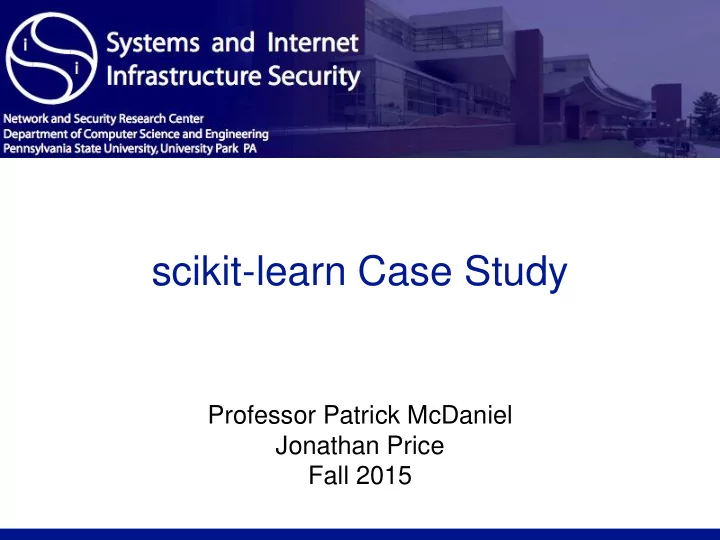

scikit-learn Case Study Professor Patrick McDaniel Jonathan Price Fall 2015
More Advanced Usage • Here, we will do a more advanced usage of scikit learn to solve an actual security problem. We will using the Microsoft Malware Classification Kaggle competition as our test case, and examine the solution of Nate Lageman (who has previously given a talk on this subject). • You will improve upon one of these learning methods as an assignment. Page
Malware Classification • "A difficult challenge of anti-malware is the vast number of files that need to be examined. As the number of files continues to grow, the need for better malware classification increases. By successfully classifying malware into respective families, we can relieve some of the load caused by the sea of files that need to be classified. Knowing the family of a particular malicious files allows us to make predictions about that file. For instance, we could sort multiple malicious files, assign threat values, and delegate resources appropriately. The goal of this project is to classify malicious files into their respective families of malicious software. There are 9 malicious families associated with this dataset." Page
The Workshop • We will walk through a high level design for classifying the malware data. We will use two prior works as a guide, and gain basic experience in the following: ‣ Binary Analysis ‣ Feature Engineering ‣ Classification methods in scikit-learn • This will be a high level discussion, to show what is possible in this field, rather than designing these solutions from scratch Page
The Data • Set of known malware files representing a mix of 9 different families. • Each malware file has an Id, a 20 character hash value uniquely identifying the file, and a Class, an integer representing one of 9 family names to which the malware may belong. • Raw data contains the hexadecimal representation of the file's binary content, without the PE header (to ensure sterility). • A metadata manifest, which is a log containing various metadata information extracted from the binary, such as function calls, strings, etc. Page
Feature Extraction • You’ve looked at sample data as pre -work, lets do some feature engineering • What features does the data have that you can think of? • What did Nate use? Page
Feature Extraction • You’ve looked at sample data as pre -work, lets do some feature engineering • What features does the data have that you can think of? • What did Nate use? ‣ Byte Frequency ‣ First 10k bytes ‣ Keyword frequency (metadata) Page
Feature Extraction Page
Feature Extraction Page
Classification • We will go over the implementation and effectiveness of five different classification methods: ‣ Random Forests ‣ Support Vector Machines ‣ K-Nearest Neighbor ‣ Gradient Boosting Page
Random Forest • Ensemble learning method ‣ (This means it uses multiple learning methods) • Collection of decision trees, outputs the mode of the decided class • We control: ‣ Max depth of trees ‣ # of Trees ‣ Features per tree Page
Random Forest • Effect of # Of Trees: Page
Random Forest: Results • 100-Tree forest with no pruning, using 5-fold cross validation Page
Support Vector Machine • Basically the SVC we talked about last lecture • We control: ‣ Kernel • Linear • Polynomial • Exponential (rbf) ‣ Degree Page
SVM: Results • Rbf: • Polynomial: Page
K-Nearest Neighbor • Classified as the majority vote of an objects k- nearest neighbors • We control: ‣ Weights (Uniform, distance) ‣ K • Build model by increasing k by 1, stop when log- loss stops improving. Page
KNN • From Wiki: • With uniform weights, what class would the new object be at k=1, 2, 3, 4...? Page
KNN: Results • K = 7 Page
Gradient Boosting • Another ensemble classifier • Also uses decision trees ‣ But regression trees this time • We control: ‣ Tree # ‣ Learning Rate ‣ Max Depth of trees Page
Gradient Boosting: Results Page
Conclusion • Random Forest and Gradient Boosting preformed the best (why?) • Counting and frequency features preformed the best (why?) Page
Assignment • Improve this! • Take the script code and improve (one) of the methods we went over. Pick your favorite. • Use the modified dataset distributed to the class (Its smaller, this will take less time) • Bonus: Read the report of the winning Kaggle entry and compare it to the methods we went over. Page
Recommend
More recommend